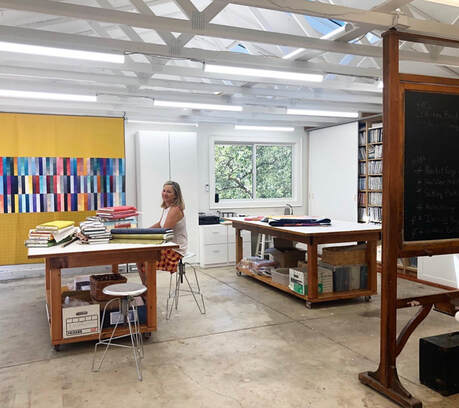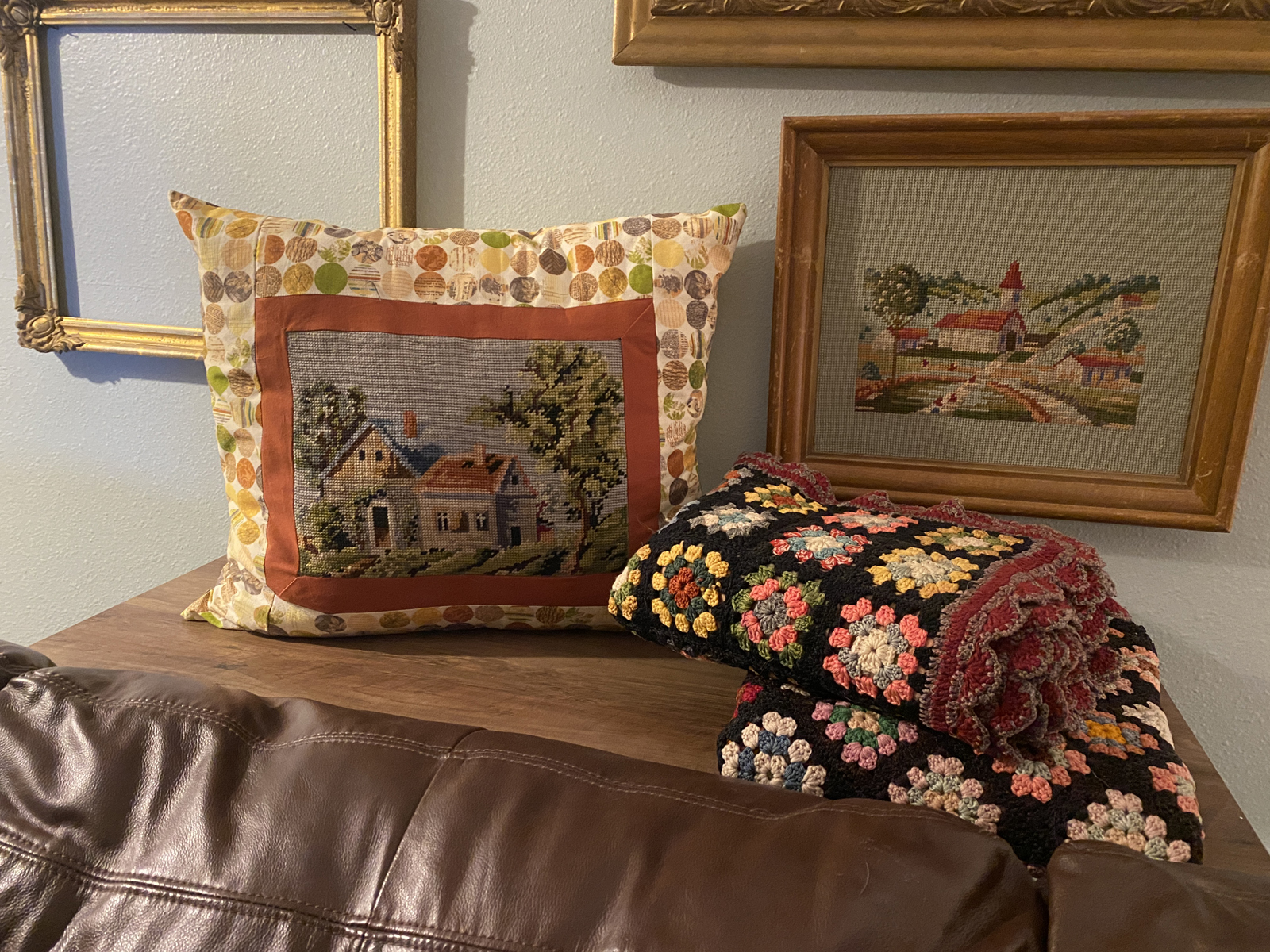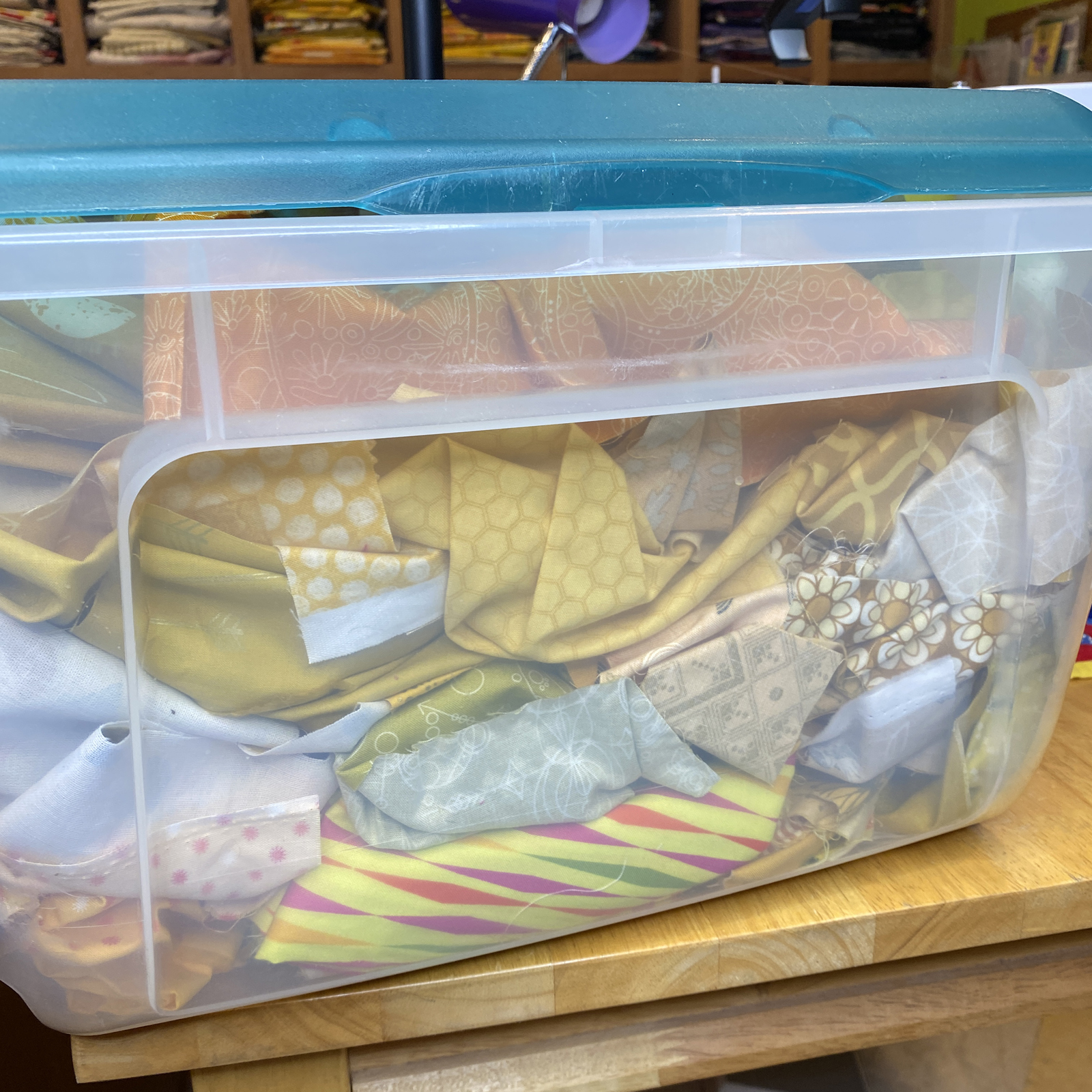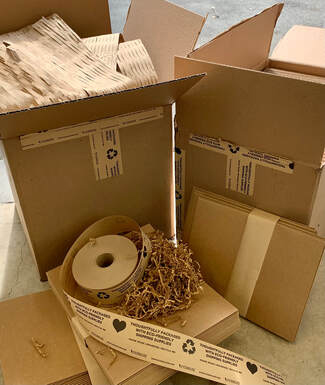Three makers explore art and sustainability through crafts
Apr 22nd 2022
Often for makers, the biggest environmental impact comes from working with materials. Despite the negative image of a towering mountain of scraps, foundation paper, and threads, there is so much room for sustainability and craft to meet. Artists like Judy Gauthier, Jennifer Sampou, and Patricia (Patty) Murphy find ways to merge art and sustainability in their craft everyday.
Known for her beautifully colored scrappy quilts, Judy is a Creative Spark Instructor and quilt artist. Jennifer is also a Creative Spark Instructor as well as a member of Create and Sustain with Patty, who published Piecing Makeover with C&T.

Judy’s "Transform Your Scraps" Creative Spark course teaches quilters to make the most of their fabric scrap piles. When she sees a pile of scraps, she instantly sorts it by color. She goes more in depth with her technique in her online course, from choosing colors to creating blocks. Though her course is fairly new, reusing material is no new concept for Judy, who puts in her two cents on the whole quilted coat debate.

“Many people are making quilted coats. I am here to tell you that this is not new! We have been doing this since the 80s. But, it’s a great way to use cast off older quilts. In addition to this, I love to go digging through thrift shops and find old needlepoint and counted cross stitch to build around. It’s so sad that some of these things end up in thrift stores when someone worked so hard to make them!” Judy.
Patty, Jennifer, and Kristi McDonough co-foundered Create and Sustain as a response to increasing global warming and climate change and Greta Thunberg’s climate advocacy speech at the UN.
“I'd been watching, too, because those are issues we care about and discuss in my home, as well. When I saw two other quilters sharing ideas about climate change, I recognized that the quilting community had room to grow; that we could do better and be an instrument for change,” said Patty.
Jennifer added, “Remember that popular old saying, 'The one who dies with the most fabric wins' used to be funny to me. Now it’s just insensitive and out of touch. As we see more clearly the effects humans have on the planet the days of over consumption must end.” As a textile designer, Jennifer has been making efforts to be more environmentally conscious by teaching more and producing less fabric collections. “SKY Ombres and Chalk and Charcoal basics are greener because they are so well supported with ideas, books, patterns and online classes,” explained Jennifer.
(Jennifer has a SKY quilt pattern out and teaches online courses on working with ombré fabrics on Creative Spark.)
Their collective goal was to clean up the quilting and crafting communities. “We have de-stashing events, there is plastic everywhere. Quilters do A LOT of good but there is so much waste and the damage textiles creates for the environment is significant so it's paramount that we address it in a healthy manner. We don't want anyone to stop quilting or buying materials; we have to sustain our industry, too!, but we want quilters, sewists and crafters to have better materials, cleaner materials. Think less toxic and less wasteful. We've stressed from the beginning it's about meeting people and companies where they are to help encourage positive change. We have to find the right balance.” explained Patty
When asked about Earth Day and sustainability in craft, here is what the artists had to say:
What does Earth day mean to you?
Judy: Earth day is particularly important to me because of where I am from. I am from Wisconsin, and our very own Senator Gaylord Nelson was the one that started Earth Day. It has deep roots in Wisconsin because of the outdoor culture that Wisconsin holds dear. Yes, we’re colder than many states in this country, but we are tough and we go outdoors even in the coldest of weather.
Patty: For me, I think it's a day to pause and intentionally think about what you do, where you go, how you live and how that impacts the Earth. Ideally we'd all do this every day but I think on Earth Day it's important to make conscious choices to do better.
Jennifer: Earth day, and every day I think about our planet fill me with tremendous joy and an aching sadness. Joy in the amazing planet we get to inhabit with all it’s natural wonders and beauty of all beings that live in harmony. Just a stroll in the woods after a spring rain reveals the most precious yet fleeting mushrooms, the sun shining on the brightest green moss glistening with life as creatures as small as ants meander by. And the horrible pit in my stomach as I continue to see first hand how human impact has has changed the world in my lifetime with everything from the climate crisis to the sickening loss of global biodiversity.

How does creativity and sustainability come together in craft?
Judy: I think that creativity and sustainability are inextricably linked. This happens when someone thinks about how they can approach their tools and what they have available to them to create art. The artist needs to think about being a good steward of their resources. We need to conserve thread, fabric and our time and energy. Therefore, we’re always planning how to do our craft efficiently.

Patty: I think people who sew have the distinct ability to use our craft in unique ways. We're all aware that we can mend garments and make quilts (or other things!) from re-purposed and upcycled materials. However, we can also use new materials to create more sustainable items like reusable "paper towels", cotton pads for taking off makeup and so much more. Creative people think differently. We see this with engineers and artists and I believe that, together, we have the ability to tap into the minds of creatives across the industry to find the right solutions. Finding sustainable solutions requires creative people.
Create and Sustain hopes we have the ability to help guide some decision making. Perhaps a maker hasn't thought about how to re-make a garment from an old shirt, or that you can serge some terry cloth scraps to make reusable paper towels. We'd like to be able to share their work with you. There are an infinite number of solutions and ideas. We hope to share that in one space.
Jennifer: Creativity and sustainability come together all the time in craft. When someone makes something by hand, it immediately becomes more valuable and therefore more sustainable. We have thought about what we want to make, have planned what materials we want to use, collected the necessary things and then we create it. It takes time and ingenuity. Crafting is a rewarding process and a key to our wellness and feeling fulfilled.
Throw away culture has to do with the fact that we use something once and give it a toss in the garbage, forgotten or actually never even thought about in the first place. Mindless, convenient, wasteful. Everytime we buy a Starbucks we think of the immediate satisfaction of drinking that yummy concoction, not about the plastic vessel that holds it, where is came from or ends up.
What are some of your sustainable habits in your daily lifestyle? How about in your studio space?
Judy: My daily sustainable habits are that I recycle a lot of cardboard! As a shop owner, I am always getting cardboard bolts and boxes. Sometimes I shred the cardboard and use it as mulch in my garden. I also like to chain piece so that thread isn’t wasted. It’s very precious!
If you’re a maker, and you want to be more environmentally aware, and cautious, then use your scraps. Try and think of ways to use fabrics that are of different substrates than just cotton. I have seen many people that will use shirts and ties and make incredible quilts…not just as memory quilts, but as a fun and alternative way of quilting. I have always encouraged that. Many people love to use denim in quilts, and it can produce a striking effect when pieces and parts of jeans are used.

Patty: There are a lot of obvious things we do at my house: recycle, compost, LED lights, and a Nest thermostat that helps us keep our heating and cooling in eco mode. We eat leftovers (when they are available. Two teen boys eat a lot!), we combine trips and I have a very small garden. We have vegetarian nights a few evenings a week, turn off lights when we aren't in a room and don't run water unnecessarily. Past that, we opt for ground shipping if something is mailed. I try to buy organic and non-GMO food when the price difference isn't outrageous, I use old dishcloths instead of paper towels, we use reusable food safe bags for school lunches, I use containers instead of plastic bags, and I have reusable cotton pads to take off makeup. I'm sure there's more! In so much of our life these practices are a habit so I can't even remember everything.
My studio is a work in progress. Right now, I'm working on minimizing what I buy and really focusing on what I have and trying to use it before buying new. It's hard. There are so many gorgeous fabrics out there but I can't possibly use all of them and it's wasteful to have it sitting on a shelf. I have a window next to my sewing machine and try to leave the lights off on nice days so I can soak in the sunlight. I always unplug my iron and machine when not in use. I re-use boxes and I'm replacing tape, tissue paper with eco-friendly options as they need replacing. I'm also making garments again!
Jennifer: We drive an electric car which is a first for us in 2022 and we compost and recycle everything possible. I reuse bags, buy loose vegetable and do my absolute best to not consume single use plastic. I reuse all plastic containers that do find their way into our home. We cut consumption of clothing, housewares and other stuff we don’t need. The kids have stopped growing and that is helpful to reduce what we buy. Outdoor activities is what we enjoy most. Biking, skiing, hiking, camping.

My studio is powered by natural light and LED. We donate all scraps (which is not much) to organizations who make charity quilts. Percentage of our fabric and pattern sales go to NRDC, Sierra Club, GreenPeace, California Whale Rescue, Elephant Nature Park and more. We use green packaging and reuse all plastic packaging that has come into our studio. Sky Ombres are all digitally printed which uses 90% less water, 30% less energy than traditional printing methods. We also use 100% biodegradable and vegan friendly dyes. We include old and d textiles in our projects for KIN Quilts and many custom quilt projects discarded.

Our environment benefits from not only makers making small changes, but companies as well. “We still have the majority of fabric companies who think more fabric is better, but I hope that changes. By focusing on how one collection can be adapted in so many ways and supported with marketing and re-order capabilities allows shops to not always be on a treadmill of constant catchup which is exhausting. It’s a mental shift as well and the most progressive shops embrace this concept,” said Jennifer.
If you made it to the end of this blog post, here is a sweet note to end on from Jennifer: “Surrounding yourself with things you find beautiful brings depth and satisfaction to your life. It’s not about the amount, it’s about the quality.”
…
Eco-friendly Tips for Makers (from our three artists)
- Make one change and stick to it
- Make reusable items, like shoppings bags and cleaning towels
- Be intentional and be honest with yourself about what you can do
- Save your scraps! (I think you can guess who shared this tip.)
- Just because something is on sale, doesn’t mean you should buy it
- Swap supplies with your friends if your stash seems uninspiring
- Make your gifts this year and support small businesses instead of big box stores!
- Work with what you have or wait to find something you really love
...
WANT MORE CREATIVE CONTENT? SIGN UP AND RECEIVE 30% OFF YOUR FIRST ORDER.







